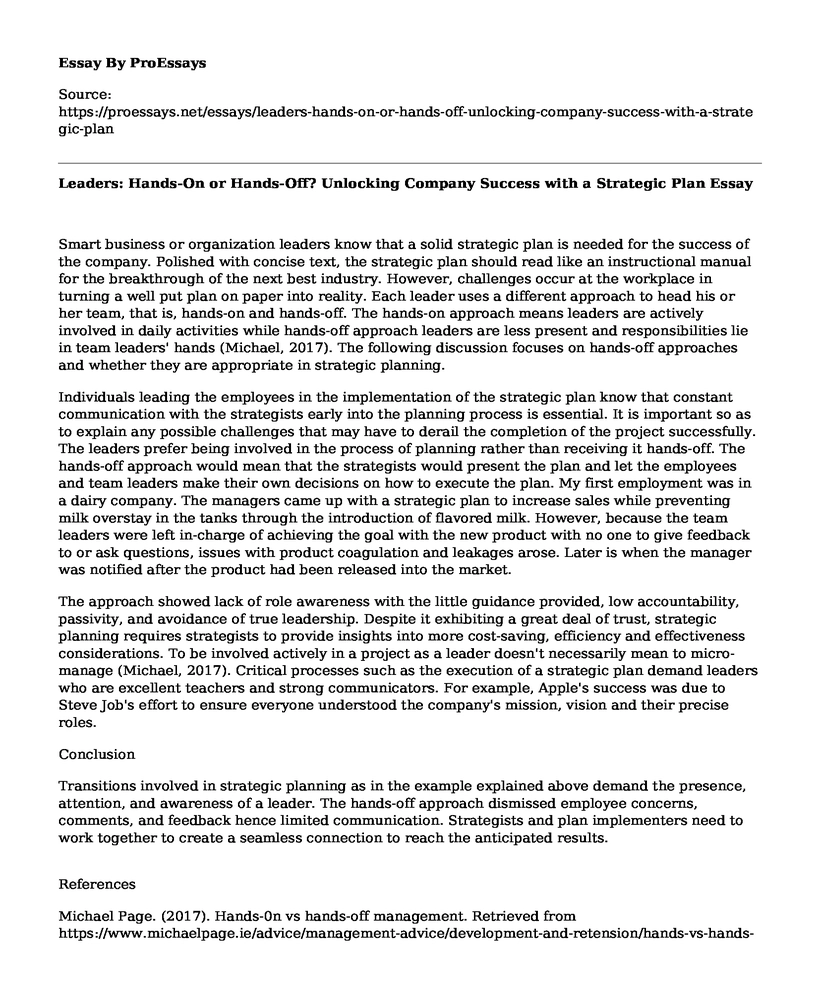Smart business or organization leaders know that a solid strategic plan is needed for the success of the company. Polished with concise text, the strategic plan should read like an instructional manual for the breakthrough of the next best industry. However, challenges occur at the workplace in turning a well put plan on paper into reality. Each leader uses a different approach to head his or her team, that is, hands-on and hands-off. The hands-on approach means leaders are actively involved in daily activities while hands-off approach leaders are less present and responsibilities lie in team leaders' hands (Michael, 2017). The following discussion focuses on hands-off approaches and whether they are appropriate in strategic planning.
Individuals leading the employees in the implementation of the strategic plan know that constant communication with the strategists early into the planning process is essential. It is important so as to explain any possible challenges that may have to derail the completion of the project successfully. The leaders prefer being involved in the process of planning rather than receiving it hands-off. The hands-off approach would mean that the strategists would present the plan and let the employees and team leaders make their own decisions on how to execute the plan. My first employment was in a dairy company. The managers came up with a strategic plan to increase sales while preventing milk overstay in the tanks through the introduction of flavored milk. However, because the team leaders were left in-charge of achieving the goal with the new product with no one to give feedback to or ask questions, issues with product coagulation and leakages arose. Later is when the manager was notified after the product had been released into the market.
The approach showed lack of role awareness with the little guidance provided, low accountability, passivity, and avoidance of true leadership. Despite it exhibiting a great deal of trust, strategic planning requires strategists to provide insights into more cost-saving, efficiency and effectiveness considerations. To be involved actively in a project as a leader doesn't necessarily mean to micro-manage (Michael, 2017). Critical processes such as the execution of a strategic plan demand leaders who are excellent teachers and strong communicators. For example, Apple's success was due to Steve Job's effort to ensure everyone understood the company's mission, vision and their precise roles.
Conclusion
Transitions involved in strategic planning as in the example explained above demand the presence, attention, and awareness of a leader. The hands-off approach dismissed employee concerns, comments, and feedback hence limited communication. Strategists and plan implementers need to work together to create a seamless connection to reach the anticipated results.
References
Michael Page. (2017). Hands-0n vs hands-off management. Retrieved from https://www.michaelpage.ie/advice/management-advice/development-and-retension/hands-vs-hands-management
Cite this page
Leaders: Hands-On or Hands-Off? Unlocking Company Success with a Strategic Plan. (2023, Jan 16). Retrieved from https://proessays.net/essays/leaders-hands-on-or-hands-off-unlocking-company-success-with-a-strategic-plan
If you are the original author of this essay and no longer wish to have it published on the ProEssays website, please click below to request its removal:
- Application of Belbin Team Roles in Healthcare Organization, Essay on HR Management
- Difficult Decision Case Study
- Essay Sample on Leadership as Necessary Component of Patient Safety and Care
- Gaining a Competitive Advantage: How Businesses Make Money Selling Goods and Services - Essay Sample
- Essay on Privacy & Security: A Closer Look at the Rights and Protections
- Paper Example on NERs, RERs, Inflation: Understanding their Interactions
- Paper Example on Reviving Professional Culture in Education







